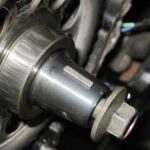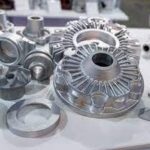The machine parts made up of stainless steel become brittle due to the Hydrogen Embrittlement. Here we will discuss hydrogen embrittlement and its effects in stainless steel.
Hydrogen embritlement is a phenomenon that makes various metals brittle. This process reduces the ductility of metals, and causes fracture due to the exposure to hydrogen. It takes place basically in forming and finishing processes of the metal, and responsible for the change in various properties. This phenomenon doesn’t affect all materials equally. The following materials may get affected highly by hydrogen embrittlement: stainless steels or inox steel, titanium, and aluminum alloys.
Fusion in Stainless Steel
The fusion in acier inoxyable or stainless steel is a process in which its melting takes place. Examples of these processes are welding and casting. When the stainless steel melts, the gas atoms present in the environment mix with the molten metal. These atoms may cause various defects inside the metal. These defects reduce the metal strength and cause the failure under smaller load. Hydrogen embrittlement may also take place due to the fusion in the stainless steel.
How Hydrogen Embrittlement Takes Place in Stainless Steel

When hydrogen comes in contact with stainless steel it diffuses along the grain boundaries of the steel. Then it combines with the carbon element of stainless steel. The combination of hydrogen and carbon causes the production of methane gas. The methane gas that is produced has a character of immobility. Due to this, it collects in small voids along the grain boundaries. These voids produce huge pressure and initiate cracking.
Effect of Temperature in Hydrogen Embrittlement
· If hydrogen embrittlement takes place at room temperature, the hydrogen atoms are then absorbed into the lattice of stainless steel. These atoms are then defused through the grains, and create lattice defects. The stress thus induced causes cracking, and the path is called transgranular.
· At high temperature, the hydrogen atoms collect in the grain boundaries, and the path of this stress-induced cracking is called intergranular.
Important Facts Regarding Hydrogen Embrittlement in Stainless Steel
· The most amazing fact of hydrogen embrittlement is that it is not permanent. After the hydrogen embrittlement, if the cracking doesn’t occur, and there is not any source of hydrogen then its atoms start rediffusing from the stainless steel. Therefore, the metal parts start restoring ductility.
- The sources of hydrogen embrittlement in stainless steel can come from the manufacturing process (welding etc.)
- Storing the stainless steel in an environment which has hydrogen as a contaminant may also be the cause of hydrogen embrittleness.
- There are some processes that produce hydrogen such as corrosion reactions, rusting, cathode protection, and electroplating. These processes then become the cause of hydrogen embrittlement.
- It’s a significant problem in nuclear industries because hydrogen is required in nuclear power plants to remove oxygen from its coolant system. This hydrogen is responsible for developing an environment of hydrogen embrittlement in the reactor causing the stainless steel parts succumb to cracking. This is the primary reason of maintaining neutral or basic pH in the coolant section.
- Phosphating and pickling operations, applied in stainless steel parts, may also cause hydrogen embrittlement. To expel the hydrogen during these operations baking heat treatment is employed.
Inspection of the Damage Due to Hydrogen Embrittlement
Hydrogen embrittlement may cause different types of damage in stainless steel. This means it’s not possible to inspect the damages only by one test. The most common tests are given below.
- Slow Strain Rate Test: used to get the information about inherent susceptibility due to the hydrogen embrittlement only for short period of time. This is avery old-fashioned method.
- Constant Load Test: used for testing threshold stress for cracking. This test is easy and provides results with good accuracy.
- To check blistering due to hydrogen embrittlement in the stainless steel you can use non-stressed coupons. In other tests, when you apply load to the stainless steel part, the part may get cracked due to the tensile stress; however, this test doesn’t cause such situations.
Actions to Prevent Hydrogen Embrittlement
- The inox steel or stainless steel used to manufacture any part must have very low levels of impurities such as phosphorous and sulfur.
- The modification of the environment is important so as to reduce hydrogen charging.
- Surface coatings and good inhibitors should be used in the stainless steel parts.
- The hardness of the stainless steel should be low.
- Heat treatment is an effective process to prevent hydrogen embrittlement.
- The high percentage of Chromium and Molybdenum in stainless steel restricts hydrogen to diffuse.
Summary
When Hydrogen embrittlement occurs in a metal like acier inoxyable or stainless steel, the material becomes brittle. The stainless steel gets fractured at lower load and in a shorter time due to decrement in the ductility of the material.
This process is based upon some factors that are given below.
- The source of the hydrogen
- The temperature during the process
- Temperature history of the stainless steel before the treatment
- Duration of the exposure of the hydrogen


